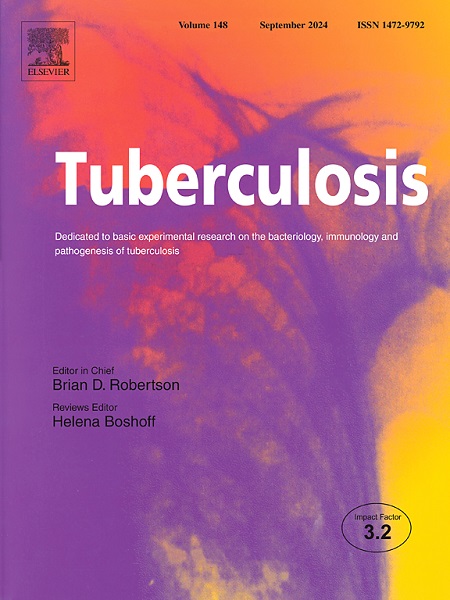Exploring novel salivary host biomarkers for immunological diagnosis of tuberculosis: A preliminary biomarker discovery study
IF 2.9
3区 医学
Q3 IMMUNOLOGY
引用次数: 0
Abstract
Tuberculosis is a serious public health concern on a global scale, which emphasises the critical need for quick and precise diagnostic and treatment response monitoring techniques. In this study, Luminex multiplex immunoassay was used to detect the concentrations of 37 host biomarkers in saliva samples from 46 patients newly diagnosed with active pulmonary tuberculosis (PTB) and 46 patients with other respiratory diseases (ORD). Multiple logistic regression and the area under the receiver operator characteristics curve (AUC) were used to evaluate the diagnostic accuracy of biomarkers, which showed significant differences between the 2 groups. This study reported that Fractalkine exhibited the highest diagnostic accuracy and excellent discriminatory power, with statistically significant results (p ≤ 0.05), an AUC of 0.91, 89.1 % sensitivity and 76.1 % specificity, highlighting its strong potential to distinguish PTB cases from ORD cases. Additionally, our study found that the median levels of IL-17A, IL-23, and VEGF were statistically significant (p ≤ 0.05). General discriminant analysis further identified Fractalkine, VEGF, GM-CSF, IL-23, and IL-1α as the top five most effective biomarkers for combinations. The backward elimination approach demonstrated the potential usefulness of a four-marker combination (Fractalkine + GM-CSF + IL-23 + IL-1α) as a confirmatory diagnostic tool by achieving the greatest overall diagnostic accuracy with an AUC of 0.94 and 91.3 % specificity. Thus, combining multiple markers with high discriminating power may improve diagnostic performance and subsequently provide a more accurate, non-invasive saliva-based PTB diagnostic tool.
探索新的唾液宿主生物标志物用于结核病的免疫学诊断:初步的生物标志物发现研究
结核病在全球范围内是一个严重的公共卫生问题,这强调了对快速和精确的诊断和治疗反应监测技术的迫切需要。本研究采用Luminex多重免疫分析法检测46例新诊断为活动性肺结核(PTB)和46例其他呼吸系统疾病(ORD)患者唾液样本中37种宿主生物标志物的浓度。采用多元logistic回归和受试者操作者特征曲线下面积(AUC)评价生物标志物的诊断准确性,两组间差异有统计学意义。本研究报道Fractalkine具有最高的诊断准确性和极好的鉴别能力,结果具有统计学意义(p≤0.05),AUC为0.91,敏感性为89.1%,特异性为76.1%,突出了其在区分PTB和ORD病例方面的强大潜力。此外,我们的研究发现,IL-17A、IL-23、VEGF的中位水平具有统计学意义(p≤0.05)。一般判别分析进一步确定Fractalkine、VEGF、GM-CSF、IL-23和IL-1α是联合治疗前五大最有效的生物标志物。反向消除方法证明了四标记物组合(Fractalkine + GM-CSF + IL-23 + IL-1α)作为确认性诊断工具的潜在有效性,AUC为0.94,特异性为91.3%,总体诊断准确性最高。因此,结合具有高鉴别能力的多个标记物可能提高诊断性能,并随后提供更准确、无创的基于唾液的PTB诊断工具。
本文章由计算机程序翻译,如有差异,请以英文原文为准。
求助全文
约1分钟内获得全文
求助全文
来源期刊

Tuberculosis
医学-呼吸系统
CiteScore
4.60
自引率
3.10%
发文量
87
审稿时长
49 days
期刊介绍:
Tuberculosis is a speciality journal focusing on basic experimental research on tuberculosis, notably on bacteriological, immunological and pathogenesis aspects of the disease. The journal publishes original research and reviews on the host response and immunology of tuberculosis and the molecular biology, genetics and physiology of the organism, however discourages submissions with a meta-analytical focus (for example, articles based on searches of published articles in public electronic databases, especially where there is lack of evidence of the personal involvement of authors in the generation of such material). We do not publish Clinical Case-Studies.
Areas on which submissions are welcomed include:
-Clinical TrialsDiagnostics-
Antimicrobial resistance-
Immunology-
Leprosy-
Microbiology, including microbial physiology-
Molecular epidemiology-
Non-tuberculous Mycobacteria-
Pathogenesis-
Pathology-
Vaccine development.
This Journal does not accept case-reports.
The resurgence of interest in tuberculosis has accelerated the pace of relevant research and Tuberculosis has grown with it, as the only journal dedicated to experimental biomedical research in tuberculosis.
 求助内容:
求助内容: 应助结果提醒方式:
应助结果提醒方式:


